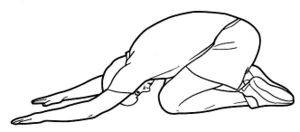Back pain is a prevalent issue that affects millions of people worldwide, often resulting from factors like poor posture, sedentary lifestyle, or muscle imbalances. While seeking medical advice is essential for chronic or severe back pain, incorporating yoga into your wellness routine can complement conventional treatments and promote long-term relief.
Understanding Back Pain: Causes and Consequences
Before delving into yoga’s potential to relieve back pain, it’s crucial to understand the underlying causes and consequences of this prevalent condition. Back pain can stem from various factors, including muscle strain, spinal misalignment, disc herniation, or underlying medical conditions.
Common Causes of Back Pain
Understanding the root causes of back pain is essential for effective management and prevention. Common culprits include muscle strain, spinal injuries, degenerative disc disease, arthritis, or structural abnormalities. Lifestyle factors such as poor posture, sedentary behavior, obesity, or stress can also contribute to back pain and affect overall spinal health.
Consequences of Untreated Back Pain
Untreated back pain can significantly impact an individual’s quality of life, affecting mobility, sleep, and daily activities. Chronic back pain may lead to decreased productivity, impaired physical function, and emotional distress, negatively impacting mental well-being and overall health. Addressing back pain promptly and adopting preventive measures is crucial for mitigating its long-term consequences.
The Therapeutic Benefits of Yoga for Back Pain
Yoga offers a holistic approach to back pain management, combining physical postures, breathwork, and mindfulness techniques to address pain and promote healing from within. By cultivating awareness of body alignment, improving flexibility, and strengthening supportive muscles, yoga can alleviate discomfort, restore spinal health, and enhance overall well-being.
Enhancing Spinal Health Through Yoga
Yoga’s gentle yet effective approach to movement makes it an ideal practice for promoting spinal health and alleviating back pain. By practicing yoga regularly, individuals can improve posture, increase spinal flexibility, and reduce muscle tension, thereby reducing the risk of back pain and enhancing overall spinal health.
Strengthening Supportive Muscles
Yoga targets both large and small muscle groups, including those that support the spine and promote stability and mobility. Poses like Cat-Cow, Bridge, and Cobra help strengthen the core, back, and abdominal muscles, providing support to the spine and reducing the risk of injury or strain.
Effective Yoga Poses for Back Pain Relief
Certain yoga poses are particularly beneficial for relieving back pain, targeting areas of tension, improving flexibility, and promoting relaxation. Incorporating these poses into your daily routine can help alleviate discomfort and prevent future episodes of back pain.
Cat-Cow Pose (Marjaryasana-Bitilasana)

Cat-Cow Pose is a gentle spinal warm-up that helps improve flexibility and mobility in the spine. By alternating between arching and rounding the back, this pose releases tension in the muscles surrounding the spine, providing relief from stiffness and discomfort.
Downward-Facing Dog (Adho Mukha Svanasana)

Downward-Facing Dog is a classic yoga pose that stretches the entire posterior chain, including the back, hamstrings, and calves. By lengthening the spine and opening the chest, this pose relieves tension in the back muscles and promotes spinal extension and alignment.
Child’s Pose (Balasana)

Child’s Pose is a restorative yoga posture that gently stretches the back muscles, hips, and thighs while promoting relaxation and stress relief. By folding forward and resting the forehead on the mat, practitioners can release tension in the back and elongate the spine.
Practice Mindful Movement
Approach your yoga practice with mindfulness and awareness, paying attention to your body’s sensations and limitations. Listen to your body and modify poses as needed to accommodate any discomfort or restrictions.
Focus on Breathwork
Integrate conscious breathing techniques into your practice to enhance relaxation, reduce stress, and promote body awareness. Deep, diaphragmatic breathing can help alleviate tension in the back and create a sense of calm and tranquility.
Gradually Increase Intensity
Start slowly and gradually build up the intensity and duration of your yoga practice over time.

1 thought on “Yoga for Back Pain: Alleviating Discomfort Through Mindful Movement”